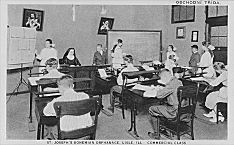| Entries |
| O |
|
Orphanages
|

|
Turn-of-the-century progressive reformers like Jane Addams attacked orphanages as places that warehoused children in unhealthy, overcrowded buildings. Reformers wanted children kept at home. Despite the complaints, new orphanages continued to be built between 1890 and 1920. Major institutions like the Marks Nathan Jewish Orphan Home opened around the turn of the century. By 1910, Chicago had more than 30 children's homes. While a few were small, most housed between 200 and 900 children.
Gradually, between 1900 and 1940, orphanages did respond to the reformers' challenge. By the 1920s, almost every major orphanage had moved from the center of the city to spacious suburban campuses. A few, like the Illinois Industrial School for Boys (now known as the Glenwood School for Boys), moved far south of the city. Most, however, moved northwest. St. Hedwig's, a Roman Catholic girls' orphanage, found a home in Niles Township. The Catholic Boys Asylum in the Bridgeport neighborhood moved to Des Plaines and became St. Mary's Training School for Boys. Hannah Greenebaum Solomon, a friend of Jane Addams, spearheaded the move of the Illinois Industrial School for Girls to Park Ridge.
In those same decades, the huge dormitories housing the children during the 1800s were gradually replaced by smaller “cottages” that tried to simulate a home setting. A few institutions run by progressive Protestants and Jews shut down and became foster home placement centers. Still, more than 5,000 children remained in Chicago orphanages in the middle of the 1940s. Angel Guardian, the largest Catholic institution, housed over 1,200 children during the Great Depression.
Orphanages declined in two stages after World War II. Between 1945 and 1960, more than half the orphanages in the city, under pressure from welfare professionals, decided to either close down, turn their plants into housing for the elderly or shift their focus to the psychotherapeutic treatment of small numbers of emotionally disturbed children. Then, in the early 1970s, the Illinois Department of Children and Family Services forced almost every orphanage still operating to shut down. Angel Guardian, still housing 400 children in the early seventies, closed in 1974. By the 1980s, only the most emotionally troubled adolescents lived in institutions. Compared to previous generations, the numbers were tiny.
The Encyclopedia of Chicago © 2004 The Newberry Library. All Rights Reserved. Portions are copyrighted by other institutions and individuals. Additional information on copyright and permissions.